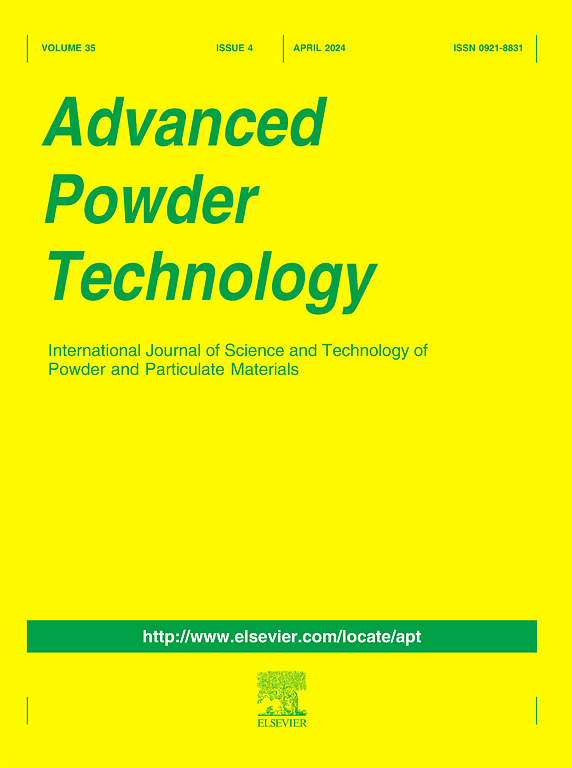接触通电对医药细粉流动性影响的DEM研究
IF 4.2
2区 工程技术
Q2 ENGINEERING, CHEMICAL
引用次数: 0
摘要
通过接触通电产生的静电电荷是决定药品细粉流动性的关键因素。本研究采用离散元法(DEM)模拟研究了这些静电效应,该方法集成了动态电荷转移模型和静电相互作用模型。通过与文献数据和FT4实验结果对比,验证了该模型的电荷积累和流动性。模拟结果表明,由于功函数的差异,电荷转移主要发生在粒子与壁面接触处,导致壁面附近粒子的电荷水平较高,然后在接触时将电荷转移给其他粒子。研究发现,排斥性静电力会降低颗粒的内聚力,从而提高流动性,而颗粒和壁面之间的强吸引像力则会产生显著的附着力。该研究还探讨了颗粒和壁之间的功函数差异以及FT4测试中的操作条件的影响。结果表明:颗粒比荷量与颗粒壁功函数差和叶片侵彻深度呈线性关系,与叶尖速度和螺旋角呈非线性关系;最后,提出了一种预测各种条件下比电荷和静电力的通用关系,为优化粉末处理工艺提供了一种简单的方法。本文章由计算机程序翻译,如有差异,请以英文原文为准。

DEM study of the effect of contact electrification on the flowability of pharmaceutical fine powders
Electrostatic charge generated through contact electrification plays a key role in determining the flowability of pharmaceutical fine powders. This study investigated these electrostatic effects using a discrete element method (DEM) simulation that integrates a dynamic charge transfer model and an electrostatic interaction model. The model was validated by comparing its predictions with literature data and FT4 experimental results for charge accumulation and flowability. Simulations revealed that charge transfer predominantly occurs at particle–wall contacts due to differences in work function, leading to a higher charge level on particles near the walls, which then transfer charges to other particles upon contact. Repulsive electrostatic forces were found to reduce particle cohesion, thereby improving flowability, whereas strong attractive image forces between particles and walls caused significant adhesion. The study also explored the effects of work function differences between particles and walls, as well as operating conditions in FT4 tests. Results indicated that the specific charge of particles exhibited a linear relationship with the particle–wall work function difference and the blade penetration depth, but a non-linear relationship with blade tip speed and helix angle. Finally, a universal relation was proposed to predict specific charge and electrostatic forces under various conditions, offering a straightforward method for optimizing powder handling processes.
求助全文
通过发布文献求助,成功后即可免费获取论文全文。
去求助
来源期刊

Advanced Powder Technology
工程技术-工程:化工
CiteScore
9.50
自引率
7.70%
发文量
424
审稿时长
55 days
期刊介绍:
The aim of Advanced Powder Technology is to meet the demand for an international journal that integrates all aspects of science and technology research on powder and particulate materials. The journal fulfills this purpose by publishing original research papers, rapid communications, reviews, and translated articles by prominent researchers worldwide.
The editorial work of Advanced Powder Technology, which was founded as the International Journal of the Society of Powder Technology, Japan, is now shared by distinguished board members, who operate in a unique framework designed to respond to the increasing global demand for articles on not only powder and particles, but also on various materials produced from them.
Advanced Powder Technology covers various areas, but a discussion of powder and particles is required in articles. Topics include: Production of powder and particulate materials in gases and liquids(nanoparticles, fine ceramics, pharmaceuticals, novel functional materials, etc.); Aerosol and colloidal processing; Powder and particle characterization; Dynamics and phenomena; Calculation and simulation (CFD, DEM, Monte Carlo method, population balance, etc.); Measurement and control of powder processes; Particle modification; Comminution; Powder handling and operations (storage, transport, granulation, separation, fluidization, etc.)
 求助内容:
求助内容: 应助结果提醒方式:
应助结果提醒方式:


